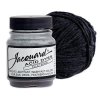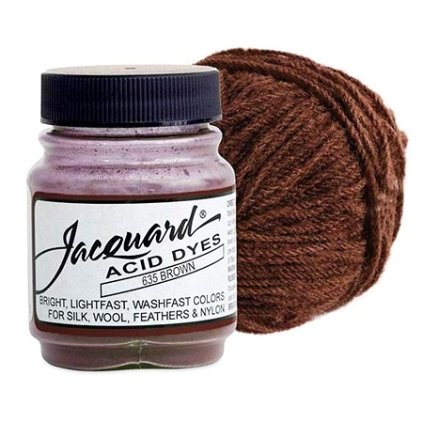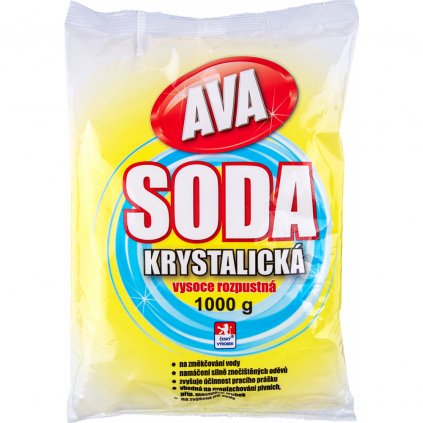Jacquard Fabric Dyes
Concentrated Jacquard powder dyes: Acid Dyes - in combination with citric acid or vinegar, it is suitable for dyeing animal fibers such as pure wool, silk, alpaca or cashmere. Procion MX, together with soda ash, dyes plant fibers such as cotton and linen and can be used to dye macrame.

Product sorting
Brands
List of products
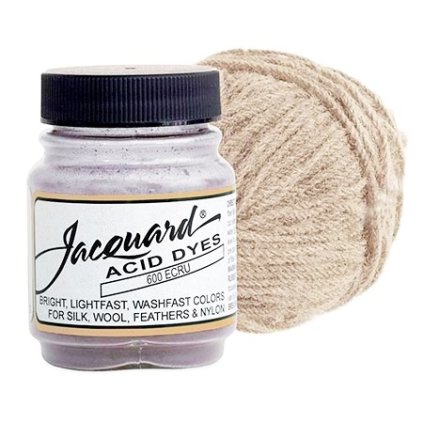
Acid dyes are used to color silk, wool, feathers, other protein fibers and nylons, and nothing does it better! Extremely brilliant and colorfast, Jacquard Acid Dyes are highly concentrated, powdered hot water dyes that produce level, uniform color during immersion dyeing. They exhaust well and won’t bleed or fade with washing. Of all the colorants in the world, acid dyes are known to produce the most luscious colors of all, and Jacquard’s palette is unsurpassed for quality, intensity and consistency. In addition to yarn, fiber and fabric dyeing, Jacquard Acid Dyes may also be used for direct painting or printing applications, using steam setting. Don’t be alarmed by the name—the only acid involved is the white vinegar or citric acid that you add to the dye bath.FABRIC/FIBER/SURFACES: nylons and protein fibers: silk, wool, cashmere, alpaca, feathers, etc.
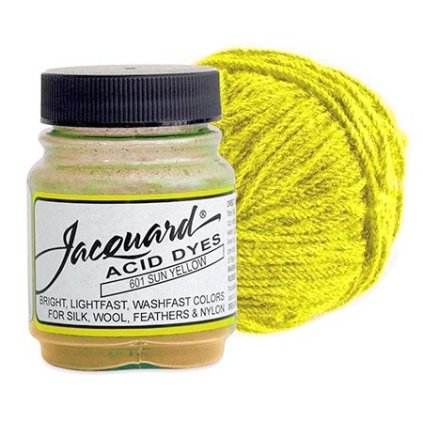
Acid dyes are used to color silk, wool, feathers, other protein fibers and nylons, and nothing does it better! Extremely brilliant and colorfast, Jacquard Acid Dyes are highly concentrated, powdered hot water dyes that produce level, uniform color during immersion dyeing. They exhaust well and won’t bleed or fade with washing. Of all the colorants in the world, acid dyes are known to produce the most luscious colors of all, and Jacquard’s palette is unsurpassed for quality, intensity and consistency. In addition to yarn, fiber and fabric dyeing, Jacquard Acid Dyes may also be used for direct painting or printing applications, using steam setting. Don’t be alarmed by the name—the only acid involved is the white vinegar or citric acid that you add to the dye bath.FABRIC/FIBER/SURFACES: nylons and protein fibers: silk, wool, cashmere, alpaca, feathers, etc.

Acid dyes are used to color silk, wool, feathers, other protein fibers and nylons, and nothing does it better! Extremely brilliant and colorfast, Jacquard Acid Dyes are highly concentrated, powdered hot water dyes that produce level, uniform color during immersion dyeing. They exhaust well and won’t bleed or fade with washing. Of all the colorants in the world, acid dyes are known to produce the most luscious colors of all, and Jacquard’s palette is unsurpassed for quality, intensity and consistency. In addition to yarn, fiber and fabric dyeing, Jacquard Acid Dyes may also be used for direct painting or printing applications, using steam setting. Don’t be alarmed by the name—the only acid involved is the white vinegar or citric acid that you add to the dye bath.FABRIC/FIBER/SURFACES: nylons and protein fibers: silk, wool, cashmere, alpaca, feathers, etc.
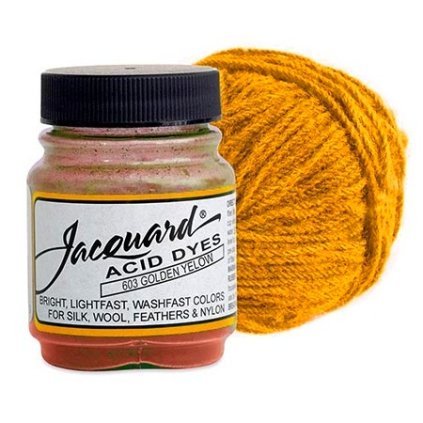
Acid dyes are used to color silk, wool, feathers, other protein fibers and nylons, and nothing does it better! Extremely brilliant and colorfast, Jacquard Acid Dyes are highly concentrated, powdered hot water dyes that produce level, uniform color during immersion dyeing. They exhaust well and won’t bleed or fade with washing. Of all the colorants in the world, acid dyes are known to produce the most luscious colors of all, and Jacquard’s palette is unsurpassed for quality, intensity and consistency. In addition to yarn, fiber and fabric dyeing, Jacquard Acid Dyes may also be used for direct painting or printing applications, using steam setting. Don’t be alarmed by the name—the only acid involved is the white vinegar or citric acid that you add to the dye bath.FABRIC/FIBER/SURFACES: nylons and protein fibers: silk, wool, cashmere, alpaca, feathers, etc.

Acid dyes are used to color silk, wool, feathers, other protein fibers and nylons, and nothing does it better! Extremely brilliant and colorfast, Jacquard Acid Dyes are highly concentrated, powdered hot water dyes that produce level, uniform color during immersion dyeing. They exhaust well and won’t bleed or fade with washing. Of all the colorants in the world, acid dyes are known to produce the most luscious colors of all, and Jacquard’s palette is unsurpassed for quality, intensity and consistency. In addition to yarn, fiber and fabric dyeing, Jacquard Acid Dyes may also be used for direct painting or printing applications, using steam setting. Don’t be alarmed by the name—the only acid involved is the white vinegar or citric acid that you add to the dye bath.FABRIC/FIBER/SURFACES: nylons and protein fibers: silk, wool, cashmere, alpaca, feathers, etc.
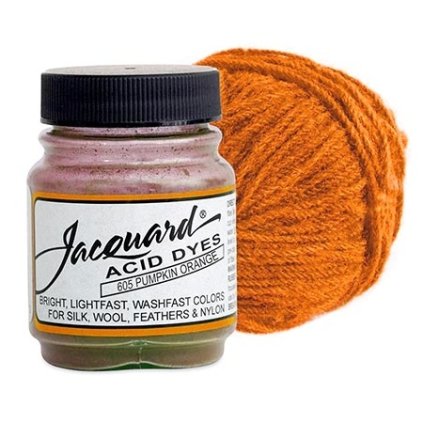
Acid dyes are used to color silk, wool, feathers, other protein fibers and nylons, and nothing does it better! Extremely brilliant and colorfast, Jacquard Acid Dyes are highly concentrated, powdered hot water dyes that produce level, uniform color during immersion dyeing. They exhaust well and won’t bleed or fade with washing. Of all the colorants in the world, acid dyes are known to produce the most luscious colors of all, and Jacquard’s palette is unsurpassed for quality, intensity and consistency. In addition to yarn, fiber and fabric dyeing, Jacquard Acid Dyes may also be used for direct painting or printing applications, using steam setting. Don’t be alarmed by the name—the only acid involved is the white vinegar or citric acid that you add to the dye bath.FABRIC/FIBER/SURFACES: nylons and protein fibers: silk, wool, cashmere, alpaca, feathers, etc.
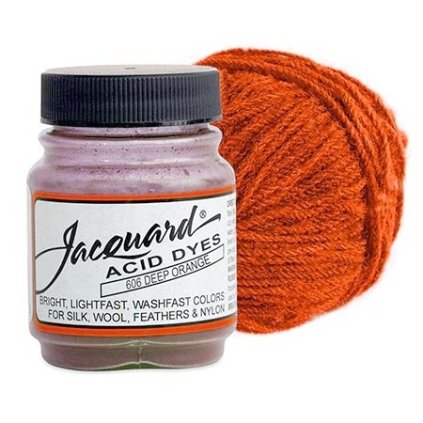
Acid dyes are used to color silk, wool, feathers, other protein fibers and nylons, and nothing does it better! Extremely brilliant and colorfast, Jacquard Acid Dyes are highly concentrated, powdered hot water dyes that produce level, uniform color during immersion dyeing. They exhaust well and won’t bleed or fade with washing. Of all the colorants in the world, acid dyes are known to produce the most luscious colors of all, and Jacquard’s palette is unsurpassed for quality, intensity and consistency. In addition to yarn, fiber and fabric dyeing, Jacquard Acid Dyes may also be used for direct painting or printing applications, using steam setting. Don’t be alarmed by the name—the only acid involved is the white vinegar or citric acid that you add to the dye bath.FABRIC/FIBER/SURFACES: nylons and protein fibers: silk, wool, cashmere, alpaca, feathers, etc.

Acid dyes are used to color silk, wool, feathers, other protein fibers and nylons, and nothing does it better! Extremely brilliant and colorfast, Jacquard Acid Dyes are highly concentrated, powdered hot water dyes that produce level, uniform color during immersion dyeing. They exhaust well and won’t bleed or fade with washing. Of all the colorants in the world, acid dyes are known to produce the most luscious colors of all, and Jacquard’s palette is unsurpassed for quality, intensity and consistency. In addition to yarn, fiber and fabric dyeing, Jacquard Acid Dyes may also be used for direct painting or printing applications, using steam setting. Don’t be alarmed by the name—the only acid involved is the white vinegar or citric acid that you add to the dye bath.FABRIC/FIBER/SURFACES: nylons and protein fibers: silk, wool, cashmere, alpaca, feathers, etc.
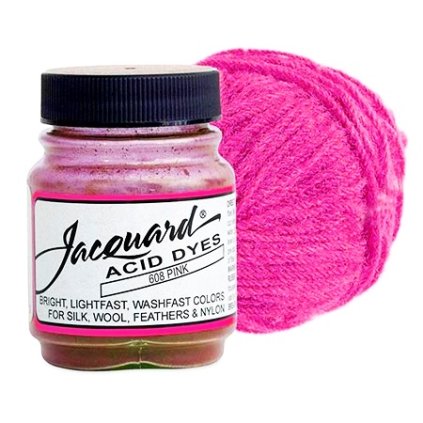
Acid dyes are used to color silk, wool, feathers, other protein fibers and nylons, and nothing does it better! Extremely brilliant and colorfast, Jacquard Acid Dyes are highly concentrated, powdered hot water dyes that produce level, uniform color during immersion dyeing. They exhaust well and won’t bleed or fade with washing. Of all the colorants in the world, acid dyes are known to produce the most luscious colors of all, and Jacquard’s palette is unsurpassed for quality, intensity and consistency. In addition to yarn, fiber and fabric dyeing, Jacquard Acid Dyes may also be used for direct painting or printing applications, using steam setting. Don’t be alarmed by the name—the only acid involved is the white vinegar or citric acid that you add to the dye bath.FABRIC/FIBER/SURFACES: nylons and protein fibers: silk, wool, cashmere, alpaca, feathers, etc.
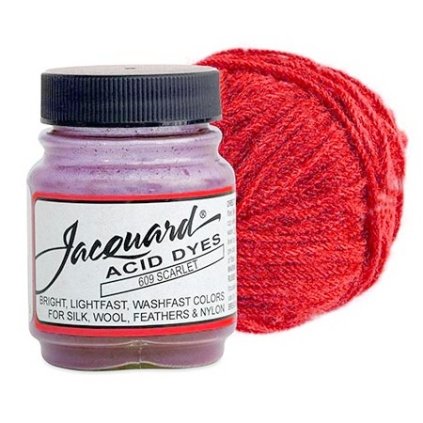
Acid dyes are used to color silk, wool, feathers, other protein fibers and nylons, and nothing does it better! Extremely brilliant and colorfast, Jacquard Acid Dyes are highly concentrated, powdered hot water dyes that produce level, uniform color during immersion dyeing. They exhaust well and won’t bleed or fade with washing. Of all the colorants in the world, acid dyes are known to produce the most luscious colors of all, and Jacquard’s palette is unsurpassed for quality, intensity and consistency. In addition to yarn, fiber and fabric dyeing, Jacquard Acid Dyes may also be used for direct painting or printing applications, using steam setting. Don’t be alarmed by the name—the only acid involved is the white vinegar or citric acid that you add to the dye bath.FABRIC/FIBER/SURFACES: nylons and protein fibers: silk, wool, cashmere, alpaca, feathers, etc.
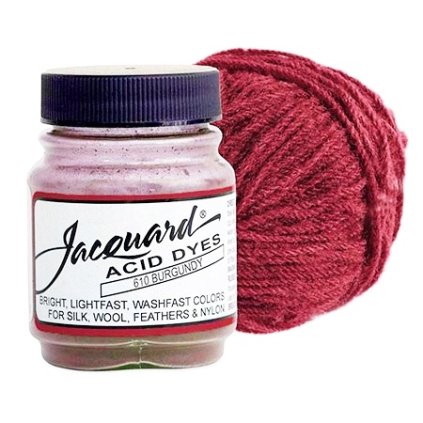
Acid dyes are used to color silk, wool, feathers, other protein fibers and nylons, and nothing does it better! Extremely brilliant and colorfast, Jacquard Acid Dyes are highly concentrated, powdered hot water dyes that produce level, uniform color during immersion dyeing. They exhaust well and won’t bleed or fade with washing. Of all the colorants in the world, acid dyes are known to produce the most luscious colors of all, and Jacquard’s palette is unsurpassed for quality, intensity and consistency. In addition to yarn, fiber and fabric dyeing, Jacquard Acid Dyes may also be used for direct painting or printing applications, using steam setting. Don’t be alarmed by the name—the only acid involved is the white vinegar or citric acid that you add to the dye bath.FABRIC/FIBER/SURFACES: nylons and protein fibers: silk, wool, cashmere, alpaca, feathers, etc.

Acid dyes are used to color silk, wool, feathers, other protein fibers and nylons, and nothing does it better! Extremely brilliant and colorfast, Jacquard Acid Dyes are highly concentrated, powdered hot water dyes that produce level, uniform color during immersion dyeing. They exhaust well and won’t bleed or fade with washing. Of all the colorants in the world, acid dyes are known to produce the most luscious colors of all, and Jacquard’s palette is unsurpassed for quality, intensity and consistency. In addition to yarn, fiber and fabric dyeing, Jacquard Acid Dyes may also be used for direct painting or printing applications, using steam setting. Don’t be alarmed by the name—the only acid involved is the white vinegar or citric acid that you add to the dye bath.FABRIC/FIBER/SURFACES: nylons and protein fibers: silk, wool, cashmere, alpaca, feathers, etc.
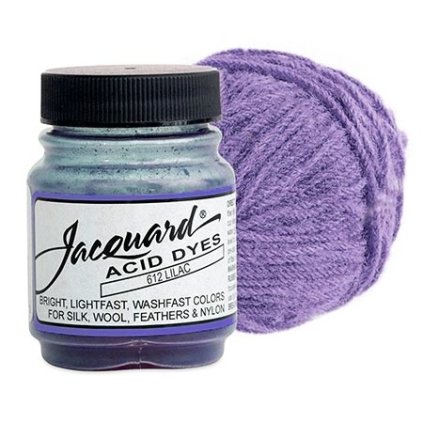
Acid dyes are used to color silk, wool, feathers, other protein fibers and nylons, and nothing does it better! Extremely brilliant and colorfast, Jacquard Acid Dyes are highly concentrated, powdered hot water dyes that produce level, uniform color during immersion dyeing. They exhaust well and won’t bleed or fade with washing. Of all the colorants in the world, acid dyes are known to produce the most luscious colors of all, and Jacquard’s palette is unsurpassed for quality, intensity and consistency. In addition to yarn, fiber and fabric dyeing, Jacquard Acid Dyes may also be used for direct painting or printing applications, using steam setting. Don’t be alarmed by the name—the only acid involved is the white vinegar or citric acid that you add to the dye bath.FABRIC/FIBER/SURFACES: nylons and protein fibers: silk, wool, cashmere, alpaca, feathers, etc.
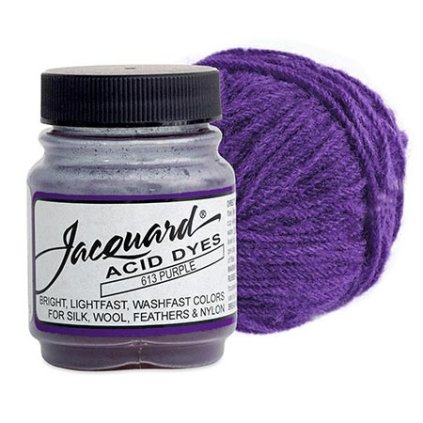
Acid dyes are used to color silk, wool, feathers, other protein fibers and nylons, and nothing does it better! Extremely brilliant and colorfast, Jacquard Acid Dyes are highly concentrated, powdered hot water dyes that produce level, uniform color during immersion dyeing. They exhaust well and won’t bleed or fade with washing. Of all the colorants in the world, acid dyes are known to produce the most luscious colors of all, and Jacquard’s palette is unsurpassed for quality, intensity and consistency. In addition to yarn, fiber and fabric dyeing, Jacquard Acid Dyes may also be used for direct painting or printing applications, using steam setting. Don’t be alarmed by the name—the only acid involved is the white vinegar or citric acid that you add to the dye bath.FABRIC/FIBER/SURFACES: nylons and protein fibers: silk, wool, cashmere, alpaca, feathers, etc.
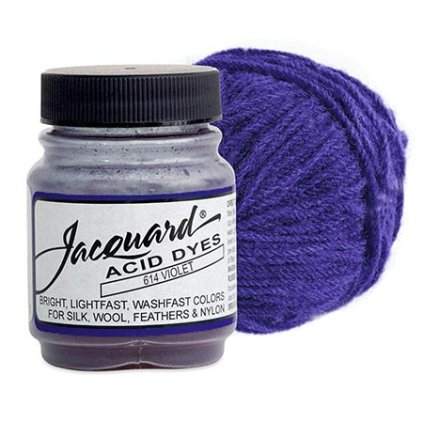
Acid dyes are used to color silk, wool, feathers, other protein fibers and nylons, and nothing does it better! Extremely brilliant and colorfast, Jacquard Acid Dyes are highly concentrated, powdered hot water dyes that produce level, uniform color during immersion dyeing. They exhaust well and won’t bleed or fade with washing. Of all the colorants in the world, acid dyes are known to produce the most luscious colors of all, and Jacquard’s palette is unsurpassed for quality, intensity and consistency. In addition to yarn, fiber and fabric dyeing, Jacquard Acid Dyes may also be used for direct painting or printing applications, using steam setting. Don’t be alarmed by the name—the only acid involved is the white vinegar or citric acid that you add to the dye bath.FABRIC/FIBER/SURFACES: nylons and protein fibers: silk, wool, cashmere, alpaca, feathers, etc.
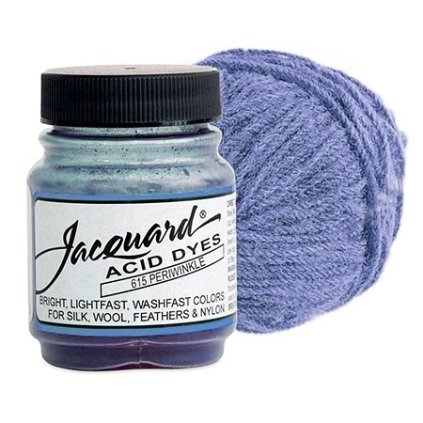
Acid dyes are used to color silk, wool, feathers, other protein fibers and nylons, and nothing does it better! Extremely brilliant and colorfast, Jacquard Acid Dyes are highly concentrated, powdered hot water dyes that produce level, uniform color during immersion dyeing. They exhaust well and won’t bleed or fade with washing. Of all the colorants in the world, acid dyes are known to produce the most luscious colors of all, and Jacquard’s palette is unsurpassed for quality, intensity and consistency. In addition to yarn, fiber and fabric dyeing, Jacquard Acid Dyes may also be used for direct painting or printing applications, using steam setting. Don’t be alarmed by the name—the only acid involved is the white vinegar or citric acid that you add to the dye bath.FABRIC/FIBER/SURFACES: nylons and protein fibers: silk, wool, cashmere, alpaca, feathers, etc.

Acid dyes are used to color silk, wool, feathers, other protein fibers and nylons, and nothing does it better! Extremely brilliant and colorfast, Jacquard Acid Dyes are highly concentrated, powdered hot water dyes that produce level, uniform color during immersion dyeing. They exhaust well and won’t bleed or fade with washing. Of all the colorants in the world, acid dyes are known to produce the most luscious colors of all, and Jacquard’s palette is unsurpassed for quality, intensity and consistency. In addition to yarn, fiber and fabric dyeing, Jacquard Acid Dyes may also be used for direct painting or printing applications, using steam setting. Don’t be alarmed by the name—the only acid involved is the white vinegar or citric acid that you add to the dye bath.FABRIC/FIBER/SURFACES: nylons and protein fibers: silk, wool, cashmere, alpaca, feathers, etc.
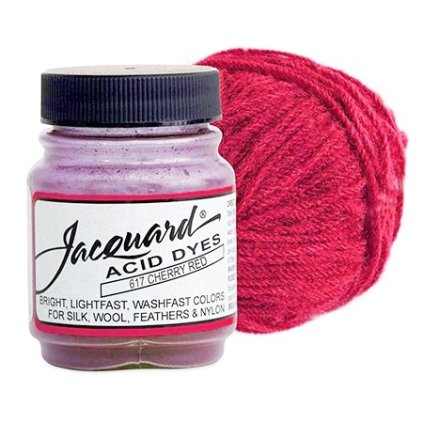
Acid dyes are used to color silk, wool, feathers, other protein fibers and nylons, and nothing does it better! Extremely brilliant and colorfast, Jacquard Acid Dyes are highly concentrated, powdered hot water dyes that produce level, uniform color during immersion dyeing. They exhaust well and won’t bleed or fade with washing. Of all the colorants in the world, acid dyes are known to produce the most luscious colors of all, and Jacquard’s palette is unsurpassed for quality, intensity and consistency. In addition to yarn, fiber and fabric dyeing, Jacquard Acid Dyes may also be used for direct painting or printing applications, using steam setting. Don’t be alarmed by the name—the only acid involved is the white vinegar or citric acid that you add to the dye bath.FABRIC/FIBER/SURFACES: nylons and protein fibers: silk, wool, cashmere, alpaca, feathers, etc.
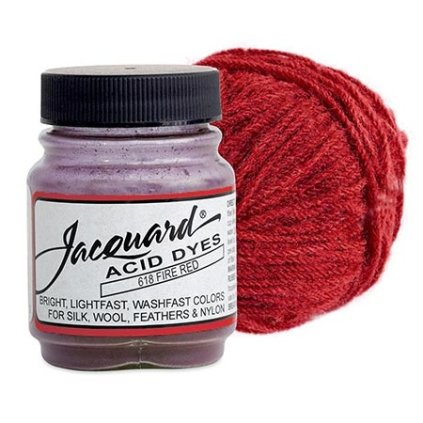
Acid dyes are used to color silk, wool, feathers, other protein fibers and nylons, and nothing does it better! Extremely brilliant and colorfast, Jacquard Acid Dyes are highly concentrated, powdered hot water dyes that produce level, uniform color during immersion dyeing. They exhaust well and won’t bleed or fade with washing. Of all the colorants in the world, acid dyes are known to produce the most luscious colors of all, and Jacquard’s palette is unsurpassed for quality, intensity and consistency. In addition to yarn, fiber and fabric dyeing, Jacquard Acid Dyes may also be used for direct painting or printing applications, using steam setting. Don’t be alarmed by the name—the only acid involved is the white vinegar or citric acid that you add to the dye bath.FABRIC/FIBER/SURFACES: nylons and protein fibers: silk, wool, cashmere, alpaca, feathers, etc.
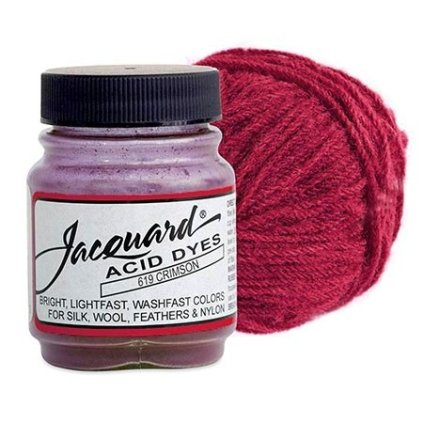
Acid dyes are used to color silk, wool, feathers, other protein fibers and nylons, and nothing does it better! Extremely brilliant and colorfast, Jacquard Acid Dyes are highly concentrated, powdered hot water dyes that produce level, uniform color during immersion dyeing. They exhaust well and won’t bleed or fade with washing. Of all the colorants in the world, acid dyes are known to produce the most luscious colors of all, and Jacquard’s palette is unsurpassed for quality, intensity and consistency. In addition to yarn, fiber and fabric dyeing, Jacquard Acid Dyes may also be used for direct painting or printing applications, using steam setting. Don’t be alarmed by the name—the only acid involved is the white vinegar or citric acid that you add to the dye bath.FABRIC/FIBER/SURFACES: nylons and protein fibers: silk, wool, cashmere, alpaca, feathers, etc.
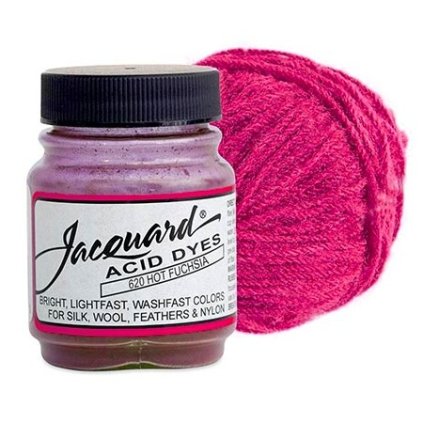
Acid dyes are used to color silk, wool, feathers, other protein fibers and nylons, and nothing does it better! Extremely brilliant and colorfast, Jacquard Acid Dyes are highly concentrated, powdered hot water dyes that produce level, uniform color during immersion dyeing. They exhaust well and won’t bleed or fade with washing. Of all the colorants in the world, acid dyes are known to produce the most luscious colors of all, and Jacquard’s palette is unsurpassed for quality, intensity and consistency. In addition to yarn, fiber and fabric dyeing, Jacquard Acid Dyes may also be used for direct painting or printing applications, using steam setting. Don’t be alarmed by the name—the only acid involved is the white vinegar or citric acid that you add to the dye bath.FABRIC/FIBER/SURFACES: nylons and protein fibers: silk, wool, cashmere, alpaca, feathers, etc.
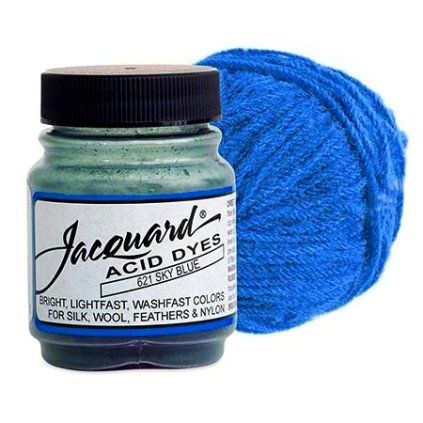
Acid dyes are used to color silk, wool, feathers, other protein fibers and nylons, and nothing does it better! Extremely brilliant and colorfast, Jacquard Acid Dyes are highly concentrated, powdered hot water dyes that produce level, uniform color during immersion dyeing. They exhaust well and won’t bleed or fade with washing. Of all the colorants in the world, acid dyes are known to produce the most luscious colors of all, and Jacquard’s palette is unsurpassed for quality, intensity and consistency. In addition to yarn, fiber and fabric dyeing, Jacquard Acid Dyes may also be used for direct painting or printing applications, using steam setting. Don’t be alarmed by the name—the only acid involved is the white vinegar or citric acid that you add to the dye bath.FABRIC/FIBER/SURFACES: nylons and protein fibers: silk, wool, cashmere, alpaca, feathers, etc.
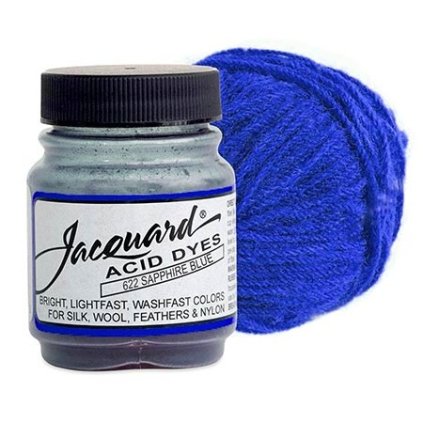
Acid dyes are used to color silk, wool, feathers, other protein fibers and nylons, and nothing does it better! Extremely brilliant and colorfast, Jacquard Acid Dyes are highly concentrated, powdered hot water dyes that produce level, uniform color during immersion dyeing. They exhaust well and won’t bleed or fade with washing. Of all the colorants in the world, acid dyes are known to produce the most luscious colors of all, and Jacquard’s palette is unsurpassed for quality, intensity and consistency. In addition to yarn, fiber and fabric dyeing, Jacquard Acid Dyes may also be used for direct painting or printing applications, using steam setting. Don’t be alarmed by the name—the only acid involved is the white vinegar or citric acid that you add to the dye bath.FABRIC/FIBER/SURFACES: nylons and protein fibers: silk, wool, cashmere, alpaca, feathers, etc.

Acid dyes are used to color silk, wool, feathers, other protein fibers and nylons, and nothing does it better! Extremely brilliant and colorfast, Jacquard Acid Dyes are highly concentrated, powdered hot water dyes that produce level, uniform color during immersion dyeing. They exhaust well and won’t bleed or fade with washing. Of all the colorants in the world, acid dyes are known to produce the most luscious colors of all, and Jacquard’s palette is unsurpassed for quality, intensity and consistency. In addition to yarn, fiber and fabric dyeing, Jacquard Acid Dyes may also be used for direct painting or printing applications, using steam setting. Don’t be alarmed by the name—the only acid involved is the white vinegar or citric acid that you add to the dye bath.FABRIC/FIBER/SURFACES: nylons and protein fibers: silk, wool, cashmere, alpaca, feathers, etc.
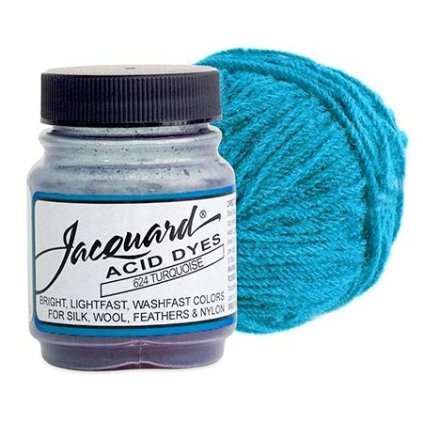
Acid dyes are used to color silk, wool, feathers, other protein fibers and nylons, and nothing does it better! Extremely brilliant and colorfast, Jacquard Acid Dyes are highly concentrated, powdered hot water dyes that produce level, uniform color during immersion dyeing. They exhaust well and won’t bleed or fade with washing. Of all the colorants in the world, acid dyes are known to produce the most luscious colors of all, and Jacquard’s palette is unsurpassed for quality, intensity and consistency. In addition to yarn, fiber and fabric dyeing, Jacquard Acid Dyes may also be used for direct painting or printing applications, using steam setting. Don’t be alarmed by the name—the only acid involved is the white vinegar or citric acid that you add to the dye bath.FABRIC/FIBER/SURFACES: nylons and protein fibers: silk, wool, cashmere, alpaca, feathers, etc.

Acid dyes are used to color silk, wool, feathers, other protein fibers and nylons, and nothing does it better! Extremely brilliant and colorfast, Jacquard Acid Dyes are highly concentrated, powdered hot water dyes that produce level, uniform color during immersion dyeing. They exhaust well and won’t bleed or fade with washing. Of all the colorants in the world, acid dyes are known to produce the most luscious colors of all, and Jacquard’s palette is unsurpassed for quality, intensity and consistency. In addition to yarn, fiber and fabric dyeing, Jacquard Acid Dyes may also be used for direct painting or printing applications, using steam setting. Don’t be alarmed by the name—the only acid involved is the white vinegar or citric acid that you add to the dye bath.FABRIC/FIBER/SURFACES: nylons and protein fibers: silk, wool, cashmere, alpaca, feathers, etc.
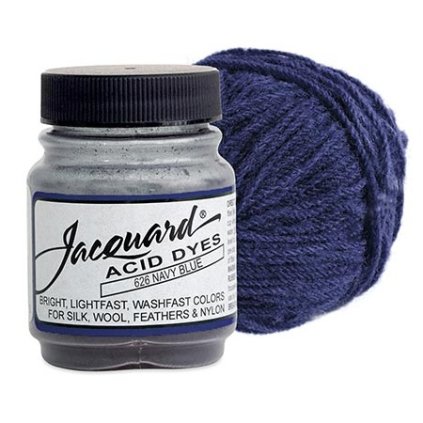
Acid dyes are used to color silk, wool, feathers, other protein fibers and nylons, and nothing does it better! Extremely brilliant and colorfast, Jacquard Acid Dyes are highly concentrated, powdered hot water dyes that produce level, uniform color during immersion dyeing. They exhaust well and won’t bleed or fade with washing. Of all the colorants in the world, acid dyes are known to produce the most luscious colors of all, and Jacquard’s palette is unsurpassed for quality, intensity and consistency. In addition to yarn, fiber and fabric dyeing, Jacquard Acid Dyes may also be used for direct painting or printing applications, using steam setting. Don’t be alarmed by the name—the only acid involved is the white vinegar or citric acid that you add to the dye bath.FABRIC/FIBER/SURFACES: nylons and protein fibers: silk, wool, cashmere, alpaca, feathers, etc.
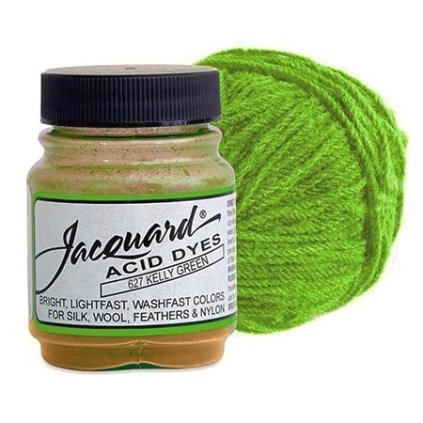
Acid dyes are used to color silk, wool, feathers, other protein fibers and nylons, and nothing does it better! Extremely brilliant and colorfast, Jacquard Acid Dyes are highly concentrated, powdered hot water dyes that produce level, uniform color during immersion dyeing. They exhaust well and won’t bleed or fade with washing. Of all the colorants in the world, acid dyes are known to produce the most luscious colors of all, and Jacquard’s palette is unsurpassed for quality, intensity and consistency. In addition to yarn, fiber and fabric dyeing, Jacquard Acid Dyes may also be used for direct painting or printing applications, using steam setting. Don’t be alarmed by the name—the only acid involved is the white vinegar or citric acid that you add to the dye bath.FABRIC/FIBER/SURFACES: nylons and protein fibers: silk, wool, cashmere, alpaca, feathers, etc.
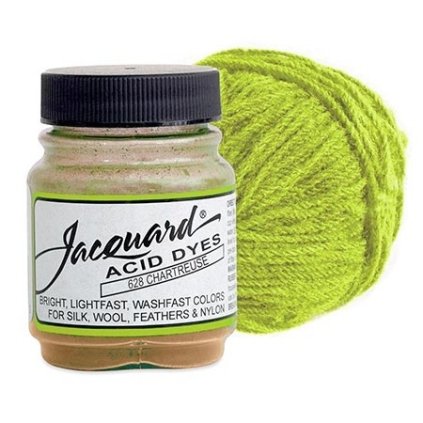
Acid dyes are used to color silk, wool, feathers, other protein fibers and nylons, and nothing does it better! Extremely brilliant and colorfast, Jacquard Acid Dyes are highly concentrated, powdered hot water dyes that produce level, uniform color during immersion dyeing. They exhaust well and won’t bleed or fade with washing. Of all the colorants in the world, acid dyes are known to produce the most luscious colors of all, and Jacquard’s palette is unsurpassed for quality, intensity and consistency. In addition to yarn, fiber and fabric dyeing, Jacquard Acid Dyes may also be used for direct painting or printing applications, using steam setting. Don’t be alarmed by the name—the only acid involved is the white vinegar or citric acid that you add to the dye bath.FABRIC/FIBER/SURFACES: nylons and protein fibers: silk, wool, cashmere, alpaca, feathers, etc.
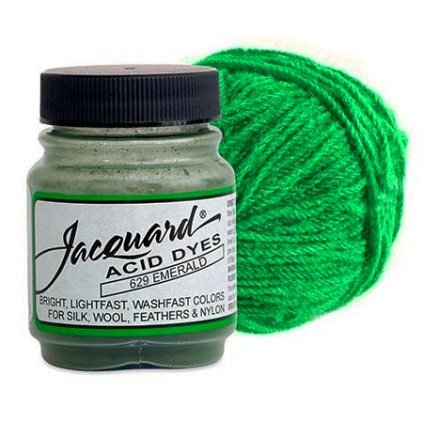
Acid dyes are used to color silk, wool, feathers, other protein fibers and nylons, and nothing does it better! Extremely brilliant and colorfast, Jacquard Acid Dyes are highly concentrated, powdered hot water dyes that produce level, uniform color during immersion dyeing. They exhaust well and won’t bleed or fade with washing. Of all the colorants in the world, acid dyes are known to produce the most luscious colors of all, and Jacquard’s palette is unsurpassed for quality, intensity and consistency. In addition to yarn, fiber and fabric dyeing, Jacquard Acid Dyes may also be used for direct painting or printing applications, using steam setting. Don’t be alarmed by the name—the only acid involved is the white vinegar or citric acid that you add to the dye bath.FABRIC/FIBER/SURFACES: nylons and protein fibers: silk, wool, cashmere, alpaca, feathers, etc.
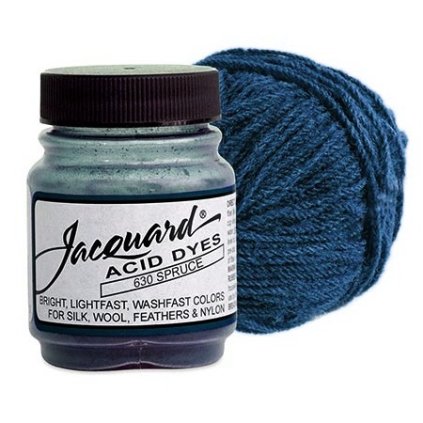
Acid dyes are used to color silk, wool, feathers, other protein fibers and nylons, and nothing does it better! Extremely brilliant and colorfast, Jacquard Acid Dyes are highly concentrated, powdered hot water dyes that produce level, uniform color during immersion dyeing. They exhaust well and won’t bleed or fade with washing. Of all the colorants in the world, acid dyes are known to produce the most luscious colors of all, and Jacquard’s palette is unsurpassed for quality, intensity and consistency. In addition to yarn, fiber and fabric dyeing, Jacquard Acid Dyes may also be used for direct painting or printing applications, using steam setting. Don’t be alarmed by the name—the only acid involved is the white vinegar or citric acid that you add to the dye bath.FABRIC/FIBER/SURFACES: nylons and protein fibers: silk, wool, cashmere, alpaca, feathers, etc.

Acid dyes are used to color silk, wool, feathers, other protein fibers and nylons, and nothing does it better! Extremely brilliant and colorfast, Jacquard Acid Dyes are highly concentrated, powdered hot water dyes that produce level, uniform color during immersion dyeing. They exhaust well and won’t bleed or fade with washing. Of all the colorants in the world, acid dyes are known to produce the most luscious colors of all, and Jacquard’s palette is unsurpassed for quality, intensity and consistency. In addition to yarn, fiber and fabric dyeing, Jacquard Acid Dyes may also be used for direct painting or printing applications, using steam setting. Don’t be alarmed by the name—the only acid involved is the white vinegar or citric acid that you add to the dye bath.FABRIC/FIBER/SURFACES: nylons and protein fibers: silk, wool, cashmere, alpaca, feathers, etc.

Acid dyes are used to color silk, wool, feathers, other protein fibers and nylons, and nothing does it better! Extremely brilliant and colorfast, Jacquard Acid Dyes are highly concentrated, powdered hot water dyes that produce level, uniform color during immersion dyeing. They exhaust well and won’t bleed or fade with washing. Of all the colorants in the world, acid dyes are known to produce the most luscious colors of all, and Jacquard’s palette is unsurpassed for quality, intensity and consistency. In addition to yarn, fiber and fabric dyeing, Jacquard Acid Dyes may also be used for direct painting or printing applications, using steam setting. Don’t be alarmed by the name—the only acid involved is the white vinegar or citric acid that you add to the dye bath.FABRIC/FIBER/SURFACES: nylons and protein fibers: silk, wool, cashmere, alpaca, feathers, etc.
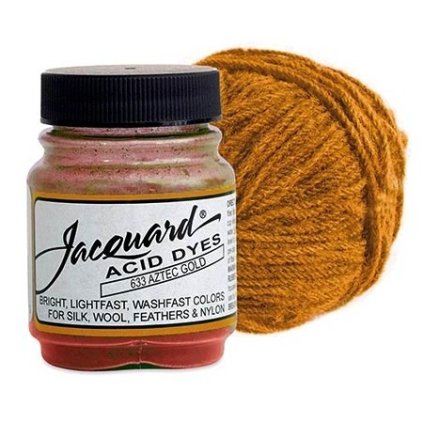
Acid dyes are used to color silk, wool, feathers, other protein fibers and nylons, and nothing does it better! Extremely brilliant and colorfast, Jacquard Acid Dyes are highly concentrated, powdered hot water dyes that produce level, uniform color during immersion dyeing. They exhaust well and won’t bleed or fade with washing. Of all the colorants in the world, acid dyes are known to produce the most luscious colors of all, and Jacquard’s palette is unsurpassed for quality, intensity and consistency. In addition to yarn, fiber and fabric dyeing, Jacquard Acid Dyes may also be used for direct painting or printing applications, using steam setting. Don’t be alarmed by the name—the only acid involved is the white vinegar or citric acid that you add to the dye bath.FABRIC/FIBER/SURFACES: nylons and protein fibers: silk, wool, cashmere, alpaca, feathers, etc.

Acid dyes are used to color silk, wool, feathers, other protein fibers and nylons, and nothing does it better! Extremely brilliant and colorfast, Jacquard Acid Dyes are highly concentrated, powdered hot water dyes that produce level, uniform color during immersion dyeing. They exhaust well and won’t bleed or fade with washing. Of all the colorants in the world, acid dyes are known to produce the most luscious colors of all, and Jacquard’s palette is unsurpassed for quality, intensity and consistency. In addition to yarn, fiber and fabric dyeing, Jacquard Acid Dyes may also be used for direct painting or printing applications, using steam setting. Don’t be alarmed by the name—the only acid involved is the white vinegar or citric acid that you add to the dye bath.FABRIC/FIBER/SURFACES: nylons and protein fibers: silk, wool, cashmere, alpaca, feathers, etc.
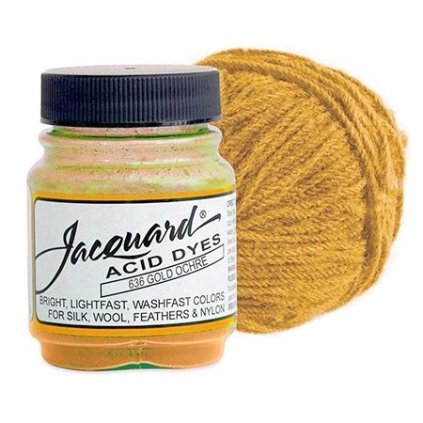
Acid dyes are used to color silk, wool, feathers, other protein fibers and nylons, and nothing does it better! Extremely brilliant and colorfast, Jacquard Acid Dyes are highly concentrated, powdered hot water dyes that produce level, uniform color during immersion dyeing. They exhaust well and won’t bleed or fade with washing. Of all the colorants in the world, acid dyes are known to produce the most luscious colors of all, and Jacquard’s palette is unsurpassed for quality, intensity and consistency. In addition to yarn, fiber and fabric dyeing, Jacquard Acid Dyes may also be used for direct painting or printing applications, using steam setting. Don’t be alarmed by the name—the only acid involved is the white vinegar or citric acid that you add to the dye bath.FABRIC/FIBER/SURFACES: nylons and protein fibers: silk, wool, cashmere, alpaca, feathers, etc.
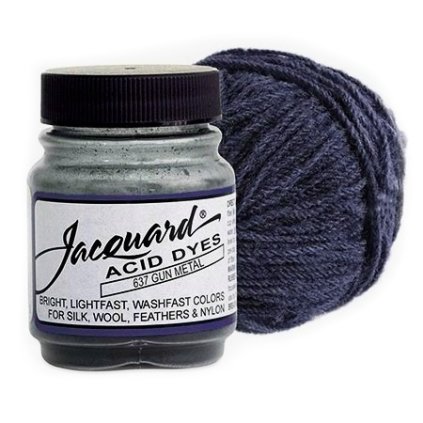
Acid dyes are used to color silk, wool, feathers, other protein fibers and nylons, and nothing does it better! Extremely brilliant and colorfast, Jacquard Acid Dyes are highly concentrated, powdered hot water dyes that produce level, uniform color during immersion dyeing. They exhaust well and won’t bleed or fade with washing. Of all the colorants in the world, acid dyes are known to produce the most luscious colors of all, and Jacquard’s palette is unsurpassed for quality, intensity and consistency. In addition to yarn, fiber and fabric dyeing, Jacquard Acid Dyes may also be used for direct painting or printing applications, using steam setting. Don’t be alarmed by the name—the only acid involved is the white vinegar or citric acid that you add to the dye bath.FABRIC/FIBER/SURFACES: nylons and protein fibers: silk, wool, cashmere, alpaca, feathers, etc.
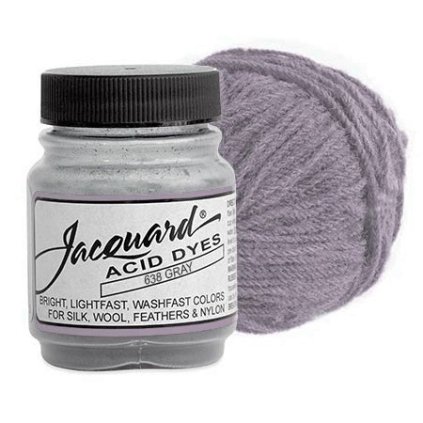
Acid dyes are used to color silk, wool, feathers, other protein fibers and nylons, and nothing does it better! Extremely brilliant and colorfast, Jacquard Acid Dyes are highly concentrated, powdered hot water dyes that produce level, uniform color during immersion dyeing. They exhaust well and won’t bleed or fade with washing. Of all the colorants in the world, acid dyes are known to produce the most luscious colors of all, and Jacquard’s palette is unsurpassed for quality, intensity and consistency. In addition to yarn, fiber and fabric dyeing, Jacquard Acid Dyes may also be used for direct painting or printing applications, using steam setting. Don’t be alarmed by the name—the only acid involved is the white vinegar or citric acid that you add to the dye bath.FABRIC/FIBER/SURFACES: nylons and protein fibers: silk, wool, cashmere, alpaca, feathers, etc.

Procion MX dyes are “cold water dyes” that are fixed chemically instead of with heat. This unique property sets Procion MX apart from all other dyes and establishes them as the undisputed king of backyard dyeing, batik and tie dye. Because Procion MX dyes can be used away from the stovetop, they are also the ideal colors for shibori, ice dyeing, tub and low water immersion dyeing, printing, direct painting and other “alternative” dye applications. As a fiber-reactive dye, Procion MX forms a strong covalent bond with cellulosic fibers, making it the most permanent and washfast of all dyestuffs. Mix the concentrated dye powder with tap water to create the most vibrant colors possible for cotton, linen and other plant-based fabrics (may also be used with protein fibers if acidified). Procion MX dyes are typically used with a soda ash fixative, which can be added directly to the dye bath or used to pretreat the fabric as in tie dyeing and other “batch setting” techniques. Typically, one...

Procion MX dyes are “cold water dyes” that are fixed chemically instead of with heat. This unique property sets Procion MX apart from all other dyes and establishes them as the undisputed king of backyard dyeing, batik and tie dye. Because Procion MX dyes can be used away from the stovetop, they are also the ideal colors for shibori, ice dyeing, tub and low water immersion dyeing, printing, direct painting and other “alternative” dye applications. As a fiber-reactive dye, Procion MX forms a strong covalent bond with cellulosic fibers, making it the most permanent and washfast of all dyestuffs. Mix the concentrated dye powder with tap water to create the most vibrant colors possible for cotton, linen and other plant-based fabrics (may also be used with protein fibers if acidified). Procion MX dyes are typically used with a soda ash fixative, which can be added directly to the dye bath or used to pretreat the fabric as in tie dyeing and other “batch setting” techniques. Typically, one...

Procion MX dyes are “cold water dyes” that are fixed chemically instead of with heat. This unique property sets Procion MX apart from all other dyes and establishes them as the undisputed king of backyard dyeing, batik and tie dye. Because Procion MX dyes can be used away from the stovetop, they are also the ideal colors for shibori, ice dyeing, tub and low water immersion dyeing, printing, direct painting and other “alternative” dye applications. As a fiber-reactive dye, Procion MX forms a strong covalent bond with cellulosic fibers, making it the most permanent and washfast of all dyestuffs. Mix the concentrated dye powder with tap water to create the most vibrant colors possible for cotton, linen and other plant-based fabrics (may also be used with protein fibers if acidified). Procion MX dyes are typically used with a soda ash fixative, which can be added directly to the dye bath or used to pretreat the fabric as in tie dyeing and other “batch setting” techniques. Typically, one...

Procion MX dyes are “cold water dyes” that are fixed chemically instead of with heat. This unique property sets Procion MX apart from all other dyes and establishes them as the undisputed king of backyard dyeing, batik and tie dye. Because Procion MX dyes can be used away from the stovetop, they are also the ideal colors for shibori, ice dyeing, tub and low water immersion dyeing, printing, direct painting and other “alternative” dye applications. As a fiber-reactive dye, Procion MX forms a strong covalent bond with cellulosic fibers, making it the most permanent and washfast of all dyestuffs. Mix the concentrated dye powder with tap water to create the most vibrant colors possible for cotton, linen and other plant-based fabrics (may also be used with protein fibers if acidified). Procion MX dyes are typically used with a soda ash fixative, which can be added directly to the dye bath or used to pretreat the fabric as in tie dyeing and other “batch setting” techniques. Typically, one...

Procion MX dyes are “cold water dyes” that are fixed chemically instead of with heat. This unique property sets Procion MX apart from all other dyes and establishes them as the undisputed king of backyard dyeing, batik and tie dye. Because Procion MX dyes can be used away from the stovetop, they are also the ideal colors for shibori, ice dyeing, tub and low water immersion dyeing, printing, direct painting and other “alternative” dye applications. As a fiber-reactive dye, Procion MX forms a strong covalent bond with cellulosic fibers, making it the most permanent and washfast of all dyestuffs. Mix the concentrated dye powder with tap water to create the most vibrant colors possible for cotton, linen and other plant-based fabrics (may also be used with protein fibers if acidified). Procion MX dyes are typically used with a soda ash fixative, which can be added directly to the dye bath or used to pretreat the fabric as in tie dyeing and other “batch setting” techniques. Typically, one...

Procion MX dyes are “cold water dyes” that are fixed chemically instead of with heat. This unique property sets Procion MX apart from all other dyes and establishes them as the undisputed king of backyard dyeing, batik and tie dye. Because Procion MX dyes can be used away from the stovetop, they are also the ideal colors for shibori, ice dyeing, tub and low water immersion dyeing, printing, direct painting and other “alternative” dye applications. As a fiber-reactive dye, Procion MX forms a strong covalent bond with cellulosic fibers, making it the most permanent and washfast of all dyestuffs. Mix the concentrated dye powder with tap water to create the most vibrant colors possible for cotton, linen and other plant-based fabrics (may also be used with protein fibers if acidified). Procion MX dyes are typically used with a soda ash fixative, which can be added directly to the dye bath or used to pretreat the fabric as in tie dyeing and other “batch setting” techniques. Typically, one...

Procion MX dyes are “cold water dyes” that are fixed chemically instead of with heat. This unique property sets Procion MX apart from all other dyes and establishes them as the undisputed king of backyard dyeing, batik and tie dye. Because Procion MX dyes can be used away from the stovetop, they are also the ideal colors for shibori, ice dyeing, tub and low water immersion dyeing, printing, direct painting and other “alternative” dye applications. As a fiber-reactive dye, Procion MX forms a strong covalent bond with cellulosic fibers, making it the most permanent and washfast of all dyestuffs. Mix the concentrated dye powder with tap water to create the most vibrant colors possible for cotton, linen and other plant-based fabrics (may also be used with protein fibers if acidified). Procion MX dyes are typically used with a soda ash fixative, which can be added directly to the dye bath or used to pretreat the fabric as in tie dyeing and other “batch setting” techniques. Typically, one...

Procion MX dyes are “cold water dyes” that are fixed chemically instead of with heat. This unique property sets Procion MX apart from all other dyes and establishes them as the undisputed king of backyard dyeing, batik and tie dye. Because Procion MX dyes can be used away from the stovetop, they are also the ideal colors for shibori, ice dyeing, tub and low water immersion dyeing, printing, direct painting and other “alternative” dye applications. As a fiber-reactive dye, Procion MX forms a strong covalent bond with cellulosic fibers, making it the most permanent and washfast of all dyestuffs. Mix the concentrated dye powder with tap water to create the most vibrant colors possible for cotton, linen and other plant-based fabrics (may also be used with protein fibers if acidified). Procion MX dyes are typically used with a soda ash fixative, which can be added directly to the dye bath or used to pretreat the fabric as in tie dyeing and other “batch setting” techniques. Typically, one...

Procion MX dyes are “cold water dyes” that are fixed chemically instead of with heat. This unique property sets Procion MX apart from all other dyes and establishes them as the undisputed king of backyard dyeing, batik and tie dye. Because Procion MX dyes can be used away from the stovetop, they are also the ideal colors for shibori, ice dyeing, tub and low water immersion dyeing, printing, direct painting and other “alternative” dye applications. As a fiber-reactive dye, Procion MX forms a strong covalent bond with cellulosic fibers, making it the most permanent and washfast of all dyestuffs. Mix the concentrated dye powder with tap water to create the most vibrant colors possible for cotton, linen and other plant-based fabrics (may also be used with protein fibers if acidified). Procion MX dyes are typically used with a soda ash fixative, which can be added directly to the dye bath or used to pretreat the fabric as in tie dyeing and other “batch setting” techniques. Typically, one...

Procion MX dyes are “cold water dyes” that are fixed chemically instead of with heat. This unique property sets Procion MX apart from all other dyes and establishes them as the undisputed king of backyard dyeing, batik and tie dye. Because Procion MX dyes can be used away from the stovetop, they are also the ideal colors for shibori, ice dyeing, tub and low water immersion dyeing, printing, direct painting and other “alternative” dye applications. As a fiber-reactive dye, Procion MX forms a strong covalent bond with cellulosic fibers, making it the most permanent and washfast of all dyestuffs. Mix the concentrated dye powder with tap water to create the most vibrant colors possible for cotton, linen and other plant-based fabrics (may also be used with protein fibers if acidified). Procion MX dyes are typically used with a soda ash fixative, which can be added directly to the dye bath or used to pretreat the fabric as in tie dyeing and other “batch setting” techniques. Typically, one...

Procion MX dyes are “cold water dyes” that are fixed chemically instead of with heat. This unique property sets Procion MX apart from all other dyes and establishes them as the undisputed king of backyard dyeing, batik and tie dye. Because Procion MX dyes can be used away from the stovetop, they are also the ideal colors for shibori, ice dyeing, tub and low water immersion dyeing, printing, direct painting and other “alternative” dye applications. As a fiber-reactive dye, Procion MX forms a strong covalent bond with cellulosic fibers, making it the most permanent and washfast of all dyestuffs. Mix the concentrated dye powder with tap water to create the most vibrant colors possible for cotton, linen and other plant-based fabrics (may also be used with protein fibers if acidified). Procion MX dyes are typically used with a soda ash fixative, which can be added directly to the dye bath or used to pretreat the fabric as in tie dyeing and other “batch setting” techniques. Typically, one...

Procion MX dyes are “cold water dyes” that are fixed chemically instead of with heat. This unique property sets Procion MX apart from all other dyes and establishes them as the undisputed king of backyard dyeing, batik and tie dye. Because Procion MX dyes can be used away from the stovetop, they are also the ideal colors for shibori, ice dyeing, tub and low water immersion dyeing, printing, direct painting and other “alternative” dye applications. As a fiber-reactive dye, Procion MX forms a strong covalent bond with cellulosic fibers, making it the most permanent and washfast of all dyestuffs. Mix the concentrated dye powder with tap water to create the most vibrant colors possible for cotton, linen and other plant-based fabrics (may also be used with protein fibers if acidified). Procion MX dyes are typically used with a soda ash fixative, which can be added directly to the dye bath or used to pretreat the fabric as in tie dyeing and other “batch setting” techniques. Typically, one...

Procion MX dyes are “cold water dyes” that are fixed chemically instead of with heat. This unique property sets Procion MX apart from all other dyes and establishes them as the undisputed king of backyard dyeing, batik and tie dye. Because Procion MX dyes can be used away from the stovetop, they are also the ideal colors for shibori, ice dyeing, tub and low water immersion dyeing, printing, direct painting and other “alternative” dye applications. As a fiber-reactive dye, Procion MX forms a strong covalent bond with cellulosic fibers, making it the most permanent and washfast of all dyestuffs. Mix the concentrated dye powder with tap water to create the most vibrant colors possible for cotton, linen and other plant-based fabrics (may also be used with protein fibers if acidified). Procion MX dyes are typically used with a soda ash fixative, which can be added directly to the dye bath or used to pretreat the fabric as in tie dyeing and other “batch setting” techniques. Typically, one...

Procion MX dyes are “cold water dyes” that are fixed chemically instead of with heat. This unique property sets Procion MX apart from all other dyes and establishes them as the undisputed king of backyard dyeing, batik and tie dye. Because Procion MX dyes can be used away from the stovetop, they are also the ideal colors for shibori, ice dyeing, tub and low water immersion dyeing, printing, direct painting and other “alternative” dye applications. As a fiber-reactive dye, Procion MX forms a strong covalent bond with cellulosic fibers, making it the most permanent and washfast of all dyestuffs. Mix the concentrated dye powder with tap water to create the most vibrant colors possible for cotton, linen and other plant-based fabrics (may also be used with protein fibers if acidified). Procion MX dyes are typically used with a soda ash fixative, which can be added directly to the dye bath or used to pretreat the fabric as in tie dyeing and other “batch setting” techniques. Typically, one...

Procion MX dyes are “cold water dyes” that are fixed chemically instead of with heat. This unique property sets Procion MX apart from all other dyes and establishes them as the undisputed king of backyard dyeing, batik and tie dye. Because Procion MX dyes can be used away from the stovetop, they are also the ideal colors for shibori, ice dyeing, tub and low water immersion dyeing, printing, direct painting and other “alternative” dye applications. As a fiber-reactive dye, Procion MX forms a strong covalent bond with cellulosic fibers, making it the most permanent and washfast of all dyestuffs. Mix the concentrated dye powder with tap water to create the most vibrant colors possible for cotton, linen and other plant-based fabrics (may also be used with protein fibers if acidified). Procion MX dyes are typically used with a soda ash fixative, which can be added directly to the dye bath or used to pretreat the fabric as in tie dyeing and other “batch setting” techniques. Typically, one...

Procion MX dyes are “cold water dyes” that are fixed chemically instead of with heat. This unique property sets Procion MX apart from all other dyes and establishes them as the undisputed king of backyard dyeing, batik and tie dye. Because Procion MX dyes can be used away from the stovetop, they are also the ideal colors for shibori, ice dyeing, tub and low water immersion dyeing, printing, direct painting and other “alternative” dye applications. As a fiber-reactive dye, Procion MX forms a strong covalent bond with cellulosic fibers, making it the most permanent and washfast of all dyestuffs. Mix the concentrated dye powder with tap water to create the most vibrant colors possible for cotton, linen and other plant-based fabrics (may also be used with protein fibers if acidified). Procion MX dyes are typically used with a soda ash fixative, which can be added directly to the dye bath or used to pretreat the fabric as in tie dyeing and other “batch setting” techniques. Typically, one...

Procion MX dyes are “cold water dyes” that are fixed chemically instead of with heat. This unique property sets Procion MX apart from all other dyes and establishes them as the undisputed king of backyard dyeing, batik and tie dye. Because Procion MX dyes can be used away from the stovetop, they are also the ideal colors for shibori, ice dyeing, tub and low water immersion dyeing, printing, direct painting and other “alternative” dye applications. As a fiber-reactive dye, Procion MX forms a strong covalent bond with cellulosic fibers, making it the most permanent and washfast of all dyestuffs. Mix the concentrated dye powder with tap water to create the most vibrant colors possible for cotton, linen and other plant-based fabrics (may also be used with protein fibers if acidified). Procion MX dyes are typically used with a soda ash fixative, which can be added directly to the dye bath or used to pretreat the fabric as in tie dyeing and other “batch setting” techniques. Typically, one...

Procion MX dyes are “cold water dyes” that are fixed chemically instead of with heat. This unique property sets Procion MX apart from all other dyes and establishes them as the undisputed king of backyard dyeing, batik and tie dye. Because Procion MX dyes can be used away from the stovetop, they are also the ideal colors for shibori, ice dyeing, tub and low water immersion dyeing, printing, direct painting and other “alternative” dye applications. As a fiber-reactive dye, Procion MX forms a strong covalent bond with cellulosic fibers, making it the most permanent and washfast of all dyestuffs. Mix the concentrated dye powder with tap water to create the most vibrant colors possible for cotton, linen and other plant-based fabrics (may also be used with protein fibers if acidified). Procion MX dyes are typically used with a soda ash fixative, which can be added directly to the dye bath or used to pretreat the fabric as in tie dyeing and other “batch setting” techniques. Typically, one...

Procion MX dyes are “cold water dyes” that are fixed chemically instead of with heat. This unique property sets Procion MX apart from all other dyes and establishes them as the undisputed king of backyard dyeing, batik and tie dye. Because Procion MX dyes can be used away from the stovetop, they are also the ideal colors for shibori, ice dyeing, tub and low water immersion dyeing, printing, direct painting and other “alternative” dye applications. As a fiber-reactive dye, Procion MX forms a strong covalent bond with cellulosic fibers, making it the most permanent and washfast of all dyestuffs. Mix the concentrated dye powder with tap water to create the most vibrant colors possible for cotton, linen and other plant-based fabrics (may also be used with protein fibers if acidified). Procion MX dyes are typically used with a soda ash fixative, which can be added directly to the dye bath or used to pretreat the fabric as in tie dyeing and other “batch setting” techniques. Typically, one...

Procion MX dyes are “cold water dyes” that are fixed chemically instead of with heat. This unique property sets Procion MX apart from all other dyes and establishes them as the undisputed king of backyard dyeing, batik and tie dye. Because Procion MX dyes can be used away from the stovetop, they are also the ideal colors for shibori, ice dyeing, tub and low water immersion dyeing, printing, direct painting and other “alternative” dye applications. As a fiber-reactive dye, Procion MX forms a strong covalent bond with cellulosic fibers, making it the most permanent and washfast of all dyestuffs. Mix the concentrated dye powder with tap water to create the most vibrant colors possible for cotton, linen and other plant-based fabrics (may also be used with protein fibers if acidified). Procion MX dyes are typically used with a soda ash fixative, which can be added directly to the dye bath or used to pretreat the fabric as in tie dyeing and other “batch setting” techniques. Typically, one...

Procion MX dyes are “cold water dyes” that are fixed chemically instead of with heat. This unique property sets Procion MX apart from all other dyes and establishes them as the undisputed king of backyard dyeing, batik and tie dye. Because Procion MX dyes can be used away from the stovetop, they are also the ideal colors for shibori, ice dyeing, tub and low water immersion dyeing, printing, direct painting and other “alternative” dye applications. As a fiber-reactive dye, Procion MX forms a strong covalent bond with cellulosic fibers, making it the most permanent and washfast of all dyestuffs. Mix the concentrated dye powder with tap water to create the most vibrant colors possible for cotton, linen and other plant-based fabrics (may also be used with protein fibers if acidified). Procion MX dyes are typically used with a soda ash fixative, which can be added directly to the dye bath or used to pretreat the fabric as in tie dyeing and other “batch setting” techniques. Typically, one...

Procion MX dyes are “cold water dyes” that are fixed chemically instead of with heat. This unique property sets Procion MX apart from all other dyes and establishes them as the undisputed king of backyard dyeing, batik and tie dye. Because Procion MX dyes can be used away from the stovetop, they are also the ideal colors for shibori, ice dyeing, tub and low water immersion dyeing, printing, direct painting and other “alternative” dye applications. As a fiber-reactive dye, Procion MX forms a strong covalent bond with cellulosic fibers, making it the most permanent and washfast of all dyestuffs. Mix the concentrated dye powder with tap water to create the most vibrant colors possible for cotton, linen and other plant-based fabrics (may also be used with protein fibers if acidified). Procion MX dyes are typically used with a soda ash fixative, which can be added directly to the dye bath or used to pretreat the fabric as in tie dyeing and other “batch setting” techniques. Typically, one...

Procion MX dyes are “cold water dyes” that are fixed chemically instead of with heat. This unique property sets Procion MX apart from all other dyes and establishes them as the undisputed king of backyard dyeing, batik and tie dye. Because Procion MX dyes can be used away from the stovetop, they are also the ideal colors for shibori, ice dyeing, tub and low water immersion dyeing, printing, direct painting and other “alternative” dye applications. As a fiber-reactive dye, Procion MX forms a strong covalent bond with cellulosic fibers, making it the most permanent and washfast of all dyestuffs. Mix the concentrated dye powder with tap water to create the most vibrant colors possible for cotton, linen and other plant-based fabrics (may also be used with protein fibers if acidified). Procion MX dyes are typically used with a soda ash fixative, which can be added directly to the dye bath or used to pretreat the fabric as in tie dyeing and other “batch setting” techniques. Typically, one...

Procion MX dyes are “cold water dyes” that are fixed chemically instead of with heat. This unique property sets Procion MX apart from all other dyes and establishes them as the undisputed king of backyard dyeing, batik and tie dye. Because Procion MX dyes can be used away from the stovetop, they are also the ideal colors for shibori, ice dyeing, tub and low water immersion dyeing, printing, direct painting and other “alternative” dye applications. As a fiber-reactive dye, Procion MX forms a strong covalent bond with cellulosic fibers, making it the most permanent and washfast of all dyestuffs. Mix the concentrated dye powder with tap water to create the most vibrant colors possible for cotton, linen and other plant-based fabrics (may also be used with protein fibers if acidified). Procion MX dyes are typically used with a soda ash fixative, which can be added directly to the dye bath or used to pretreat the fabric as in tie dyeing and other “batch setting” techniques. Typically, one...

Procion MX dyes are “cold water dyes” that are fixed chemically instead of with heat. This unique property sets Procion MX apart from all other dyes and establishes them as the undisputed king of backyard dyeing, batik and tie dye. Because Procion MX dyes can be used away from the stovetop, they are also the ideal colors for shibori, ice dyeing, tub and low water immersion dyeing, printing, direct painting and other “alternative” dye applications. As a fiber-reactive dye, Procion MX forms a strong covalent bond with cellulosic fibers, making it the most permanent and washfast of all dyestuffs. Mix the concentrated dye powder with tap water to create the most vibrant colors possible for cotton, linen and other plant-based fabrics (may also be used with protein fibers if acidified). Procion MX dyes are typically used with a soda ash fixative, which can be added directly to the dye bath or used to pretreat the fabric as in tie dyeing and other “batch setting” techniques. Typically, one...

Procion MX dyes are “cold water dyes” that are fixed chemically instead of with heat. This unique property sets Procion MX apart from all other dyes and establishes them as the undisputed king of backyard dyeing, batik and tie dye. Because Procion MX dyes can be used away from the stovetop, they are also the ideal colors for shibori, ice dyeing, tub and low water immersion dyeing, printing, direct painting and other “alternative” dye applications. As a fiber-reactive dye, Procion MX forms a strong covalent bond with cellulosic fibers, making it the most permanent and washfast of all dyestuffs. Mix the concentrated dye powder with tap water to create the most vibrant colors possible for cotton, linen and other plant-based fabrics (may also be used with protein fibers if acidified). Procion MX dyes are typically used with a soda ash fixative, which can be added directly to the dye bath or used to pretreat the fabric as in tie dyeing and other “batch setting” techniques. Typically, one...

Procion MX dyes are “cold water dyes” that are fixed chemically instead of with heat. This unique property sets Procion MX apart from all other dyes and establishes them as the undisputed king of backyard dyeing, batik and tie dye. Because Procion MX dyes can be used away from the stovetop, they are also the ideal colors for shibori, ice dyeing, tub and low water immersion dyeing, printing, direct painting and other “alternative” dye applications. As a fiber-reactive dye, Procion MX forms a strong covalent bond with cellulosic fibers, making it the most permanent and washfast of all dyestuffs. Mix the concentrated dye powder with tap water to create the most vibrant colors possible for cotton, linen and other plant-based fabrics (may also be used with protein fibers if acidified). Procion MX dyes are typically used with a soda ash fixative, which can be added directly to the dye bath or used to pretreat the fabric as in tie dyeing and other “batch setting” techniques. Typically, one...

Procion MX dyes are “cold water dyes” that are fixed chemically instead of with heat. This unique property sets Procion MX apart from all other dyes and establishes them as the undisputed king of backyard dyeing, batik and tie dye. Because Procion MX dyes can be used away from the stovetop, they are also the ideal colors for shibori, ice dyeing, tub and low water immersion dyeing, printing, direct painting and other “alternative” dye applications. As a fiber-reactive dye, Procion MX forms a strong covalent bond with cellulosic fibers, making it the most permanent and washfast of all dyestuffs. Mix the concentrated dye powder with tap water to create the most vibrant colors possible for cotton, linen and other plant-based fabrics (may also be used with protein fibers if acidified). Procion MX dyes are typically used with a soda ash fixative, which can be added directly to the dye bath or used to pretreat the fabric as in tie dyeing and other “batch setting” techniques. Typically, one...

Procion MX dyes are “cold water dyes” that are fixed chemically instead of with heat. This unique property sets Procion MX apart from all other dyes and establishes them as the undisputed king of backyard dyeing, batik and tie dye. Because Procion MX dyes can be used away from the stovetop, they are also the ideal colors for shibori, ice dyeing, tub and low water immersion dyeing, printing, direct painting and other “alternative” dye applications. As a fiber-reactive dye, Procion MX forms a strong covalent bond with cellulosic fibers, making it the most permanent and washfast of all dyestuffs. Mix the concentrated dye powder with tap water to create the most vibrant colors possible for cotton, linen and other plant-based fabrics (may also be used with protein fibers if acidified). Procion MX dyes are typically used with a soda ash fixative, which can be added directly to the dye bath or used to pretreat the fabric as in tie dyeing and other “batch setting” techniques. Typically, one...

Procion MX dyes are “cold water dyes” that are fixed chemically instead of with heat. This unique property sets Procion MX apart from all other dyes and establishes them as the undisputed king of backyard dyeing, batik and tie dye. Because Procion MX dyes can be used away from the stovetop, they are also the ideal colors for shibori, ice dyeing, tub and low water immersion dyeing, printing, direct painting and other “alternative” dye applications. As a fiber-reactive dye, Procion MX forms a strong covalent bond with cellulosic fibers, making it the most permanent and washfast of all dyestuffs. Mix the concentrated dye powder with tap water to create the most vibrant colors possible for cotton, linen and other plant-based fabrics (may also be used with protein fibers if acidified). Procion MX dyes are typically used with a soda ash fixative, which can be added directly to the dye bath or used to pretreat the fabric as in tie dyeing and other “batch setting” techniques. Typically, one...

Procion MX dyes are “cold water dyes” that are fixed chemically instead of with heat. This unique property sets Procion MX apart from all other dyes and establishes them as the undisputed king of backyard dyeing, batik and tie dye. Because Procion MX dyes can be used away from the stovetop, they are also the ideal colors for shibori, ice dyeing, tub and low water immersion dyeing, printing, direct painting and other “alternative” dye applications. As a fiber-reactive dye, Procion MX forms a strong covalent bond with cellulosic fibers, making it the most permanent and washfast of all dyestuffs. Mix the concentrated dye powder with tap water to create the most vibrant colors possible for cotton, linen and other plant-based fabrics (may also be used with protein fibers if acidified). Procion MX dyes are typically used with a soda ash fixative, which can be added directly to the dye bath or used to pretreat the fabric as in tie dyeing and other “batch setting” techniques. Typically, one...

Procion MX dyes are “cold water dyes” that are fixed chemically instead of with heat. This unique property sets Procion MX apart from all other dyes and establishes them as the undisputed king of backyard dyeing, batik and tie dye. Because Procion MX dyes can be used away from the stovetop, they are also the ideal colors for shibori, ice dyeing, tub and low water immersion dyeing, printing, direct painting and other “alternative” dye applications. As a fiber-reactive dye, Procion MX forms a strong covalent bond with cellulosic fibers, making it the most permanent and washfast of all dyestuffs. Mix the concentrated dye powder with tap water to create the most vibrant colors possible for cotton, linen and other plant-based fabrics (may also be used with protein fibers if acidified). Procion MX dyes are typically used with a soda ash fixative, which can be added directly to the dye bath or used to pretreat the fabric as in tie dyeing and other “batch setting” techniques. Typically, one...

Procion MX dyes are “cold water dyes” that are fixed chemically instead of with heat. This unique property sets Procion MX apart from all other dyes and establishes them as the undisputed king of backyard dyeing, batik and tie dye. Because Procion MX dyes can be used away from the stovetop, they are also the ideal colors for shibori, ice dyeing, tub and low water immersion dyeing, printing, direct painting and other “alternative” dye applications. As a fiber-reactive dye, Procion MX forms a strong covalent bond with cellulosic fibers, making it the most permanent and washfast of all dyestuffs. Mix the concentrated dye powder with tap water to create the most vibrant colors possible for cotton, linen and other plant-based fabrics (may also be used with protein fibers if acidified). Procion MX dyes are typically used with a soda ash fixative, which can be added directly to the dye bath or used to pretreat the fabric as in tie dyeing and other “batch setting” techniques. Typically, one...

Procion MX dyes are “cold water dyes” that are fixed chemically instead of with heat. This unique property sets Procion MX apart from all other dyes and establishes them as the undisputed king of backyard dyeing, batik and tie dye. Because Procion MX dyes can be used away from the stovetop, they are also the ideal colors for shibori, ice dyeing, tub and low water immersion dyeing, printing, direct painting and other “alternative” dye applications. As a fiber-reactive dye, Procion MX forms a strong covalent bond with cellulosic fibers, making it the most permanent and washfast of all dyestuffs. Mix the concentrated dye powder with tap water to create the most vibrant colors possible for cotton, linen and other plant-based fabrics (may also be used with protein fibers if acidified). Procion MX dyes are typically used with a soda ash fixative, which can be added directly to the dye bath or used to pretreat the fabric as in tie dyeing and other “batch setting” techniques. Typically, one...

Procion MX dyes are “cold water dyes” that are fixed chemically instead of with heat. This unique property sets Procion MX apart from all other dyes and establishes them as the undisputed king of backyard dyeing, batik and tie dye. Because Procion MX dyes can be used away from the stovetop, they are also the ideal colors for shibori, ice dyeing, tub and low water immersion dyeing, printing, direct painting and other “alternative” dye applications. As a fiber-reactive dye, Procion MX forms a strong covalent bond with cellulosic fibers, making it the most permanent and washfast of all dyestuffs. Mix the concentrated dye powder with tap water to create the most vibrant colors possible for cotton, linen and other plant-based fabrics (may also be used with protein fibers if acidified). Procion MX dyes are typically used with a soda ash fixative, which can be added directly to the dye bath or used to pretreat the fabric as in tie dyeing and other “batch setting” techniques. Typically, one...

Procion MX dyes are “cold water dyes” that are fixed chemically instead of with heat. This unique property sets Procion MX apart from all other dyes and establishes them as the undisputed king of backyard dyeing, batik and tie dye. Because Procion MX dyes can be used away from the stovetop, they are also the ideal colors for shibori, ice dyeing, tub and low water immersion dyeing, printing, direct painting and other “alternative” dye applications. As a fiber-reactive dye, Procion MX forms a strong covalent bond with cellulosic fibers, making it the most permanent and washfast of all dyestuffs. Mix the concentrated dye powder with tap water to create the most vibrant colors possible for cotton, linen and other plant-based fabrics (may also be used with protein fibers if acidified). Procion MX dyes are typically used with a soda ash fixative, which can be added directly to the dye bath or used to pretreat the fabric as in tie dyeing and other “batch setting” techniques. Typically, one...

Procion MX dyes are “cold water dyes” that are fixed chemically instead of with heat. This unique property sets Procion MX apart from all other dyes and establishes them as the undisputed king of backyard dyeing, batik and tie dye. Because Procion MX dyes can be used away from the stovetop, they are also the ideal colors for shibori, ice dyeing, tub and low water immersion dyeing, printing, direct painting and other “alternative” dye applications. As a fiber-reactive dye, Procion MX forms a strong covalent bond with cellulosic fibers, making it the most permanent and washfast of all dyestuffs. Mix the concentrated dye powder with tap water to create the most vibrant colors possible for cotton, linen and other plant-based fabrics (may also be used with protein fibers if acidified). Procion MX dyes are typically used with a soda ash fixative, which can be added directly to the dye bath or used to pretreat the fabric as in tie dyeing and other “batch setting” techniques. Typically, one...

Procion MX dyes are “cold water dyes” that are fixed chemically instead of with heat. This unique property sets Procion MX apart from all other dyes and establishes them as the undisputed king of backyard dyeing, batik and tie dye. Because Procion MX dyes can be used away from the stovetop, they are also the ideal colors for shibori, ice dyeing, tub and low water immersion dyeing, printing, direct painting and other “alternative” dye applications. As a fiber-reactive dye, Procion MX forms a strong covalent bond with cellulosic fibers, making it the most permanent and washfast of all dyestuffs. Mix the concentrated dye powder with tap water to create the most vibrant colors possible for cotton, linen and other plant-based fabrics (may also be used with protein fibers if acidified). Procion MX dyes are typically used with a soda ash fixative, which can be added directly to the dye bath or used to pretreat the fabric as in tie dyeing and other “batch setting” techniques. Typically, one...

Procion MX dyes are “cold water dyes” that are fixed chemically instead of with heat. This unique property sets Procion MX apart from all other dyes and establishes them as the undisputed king of backyard dyeing, batik and tie dye. Because Procion MX dyes can be used away from the stovetop, they are also the ideal colors for shibori, ice dyeing, tub and low water immersion dyeing, printing, direct painting and other “alternative” dye applications. As a fiber-reactive dye, Procion MX forms a strong covalent bond with cellulosic fibers, making it the most permanent and washfast of all dyestuffs. Mix the concentrated dye powder with tap water to create the most vibrant colors possible for cotton, linen and other plant-based fabrics (may also be used with protein fibers if acidified). Procion MX dyes are typically used with a soda ash fixative, which can be added directly to the dye bath or used to pretreat the fabric as in tie dyeing and other “batch setting” techniques. Typically, one...

Procion MX dyes are “cold water dyes” that are fixed chemically instead of with heat. This unique property sets Procion MX apart from all other dyes and establishes them as the undisputed king of backyard dyeing, batik and tie dye. Because Procion MX dyes can be used away from the stovetop, they are also the ideal colors for shibori, ice dyeing, tub and low water immersion dyeing, printing, direct painting and other “alternative” dye applications. As a fiber-reactive dye, Procion MX forms a strong covalent bond with cellulosic fibers, making it the most permanent and washfast of all dyestuffs. Mix the concentrated dye powder with tap water to create the most vibrant colors possible for cotton, linen and other plant-based fabrics (may also be used with protein fibers if acidified). Procion MX dyes are typically used with a soda ash fixative, which can be added directly to the dye bath or used to pretreat the fabric as in tie dyeing and other “batch setting” techniques. Typically, one...

Procion MX dyes are “cold water dyes” that are fixed chemically instead of with heat. This unique property sets Procion MX apart from all other dyes and establishes them as the undisputed king of backyard dyeing, batik and tie dye. Because Procion MX dyes can be used away from the stovetop, they are also the ideal colors for shibori, ice dyeing, tub and low water immersion dyeing, printing, direct painting and other “alternative” dye applications. As a fiber-reactive dye, Procion MX forms a strong covalent bond with cellulosic fibers, making it the most permanent and washfast of all dyestuffs. Mix the concentrated dye powder with tap water to create the most vibrant colors possible for cotton, linen and other plant-based fabrics (may also be used with protein fibers if acidified). Procion MX dyes are typically used with a soda ash fixative, which can be added directly to the dye bath or used to pretreat the fabric as in tie dyeing and other “batch setting” techniques. Typically, one...

Procion MX dyes are “cold water dyes” that are fixed chemically instead of with heat. This unique property sets Procion MX apart from all other dyes and establishes them as the undisputed king of backyard dyeing, batik and tie dye. Because Procion MX dyes can be used away from the stovetop, they are also the ideal colors for shibori, ice dyeing, tub and low water immersion dyeing, printing, direct painting and other “alternative” dye applications. As a fiber-reactive dye, Procion MX forms a strong covalent bond with cellulosic fibers, making it the most permanent and washfast of all dyestuffs. Mix the concentrated dye powder with tap water to create the most vibrant colors possible for cotton, linen and other plant-based fabrics (may also be used with protein fibers if acidified). Procion MX dyes are typically used with a soda ash fixative, which can be added directly to the dye bath or used to pretreat the fabric as in tie dyeing and other “batch setting” techniques. Typically, one...

Procion MX dyes are “cold water dyes” that are fixed chemically instead of with heat. This unique property sets Procion MX apart from all other dyes and establishes them as the undisputed king of backyard dyeing, batik and tie dye. Because Procion MX dyes can be used away from the stovetop, they are also the ideal colors for shibori, ice dyeing, tub and low water immersion dyeing, printing, direct painting and other “alternative” dye applications. As a fiber-reactive dye, Procion MX forms a strong covalent bond with cellulosic fibers, making it the most permanent and washfast of all dyestuffs. Mix the concentrated dye powder with tap water to create the most vibrant colors possible for cotton, linen and other plant-based fabrics (may also be used with protein fibers if acidified). Procion MX dyes are typically used with a soda ash fixative, which can be added directly to the dye bath or used to pretreat the fabric as in tie dyeing and other “batch setting” techniques. Typically, one...

Synthrapol® is an industrial strength, pH neutral, liquid detergent used as a prewash and afterwash for dyed or painted fabrics and as a wetting agent for fabric dyes and paints. Synthrapol® has the unique property of keeping loose dye suspended during washing, thus preventing backstaining while aiding in the removal of excess color.



